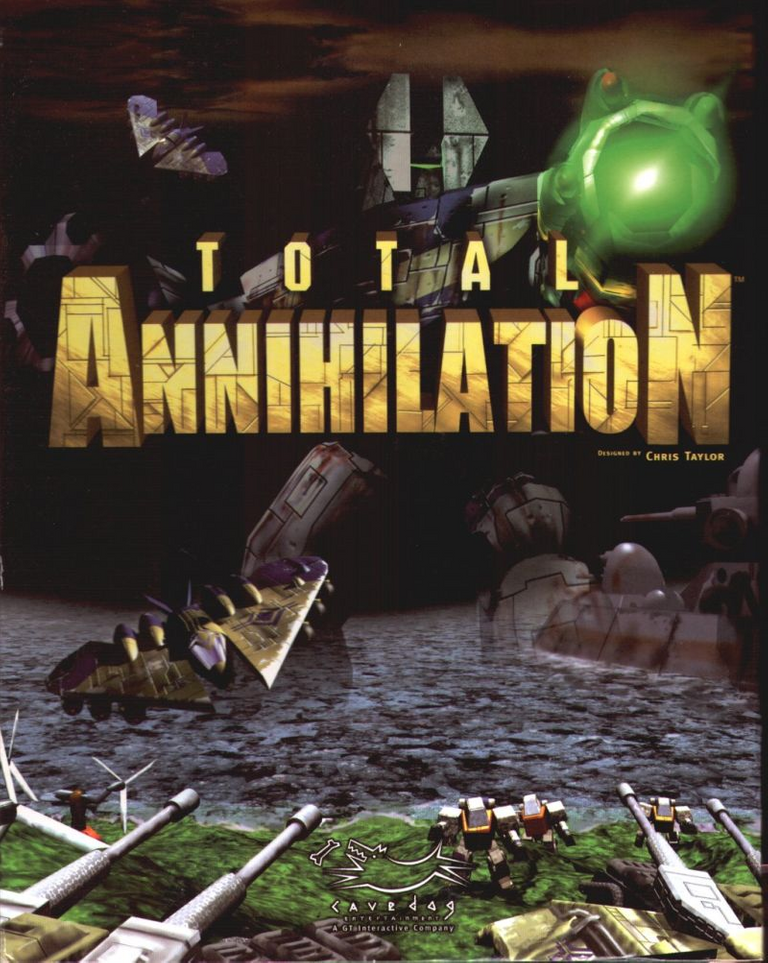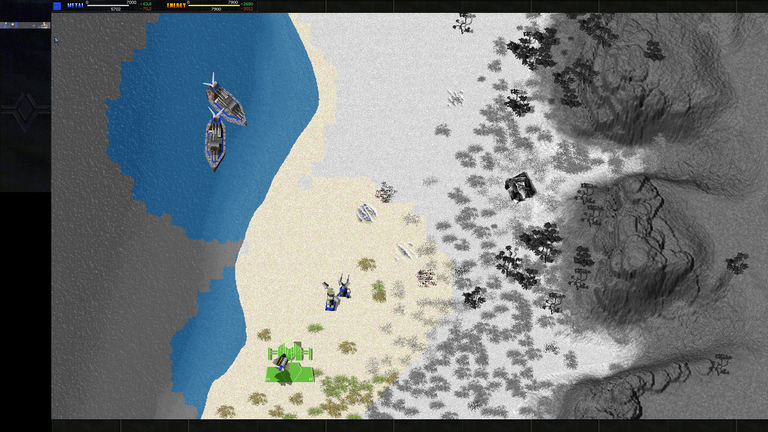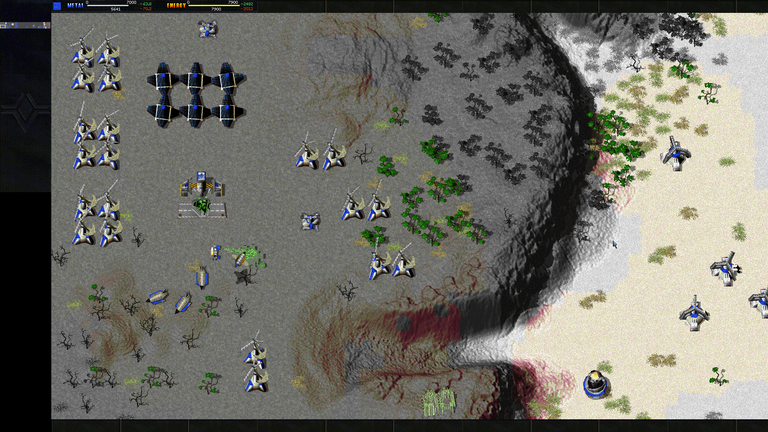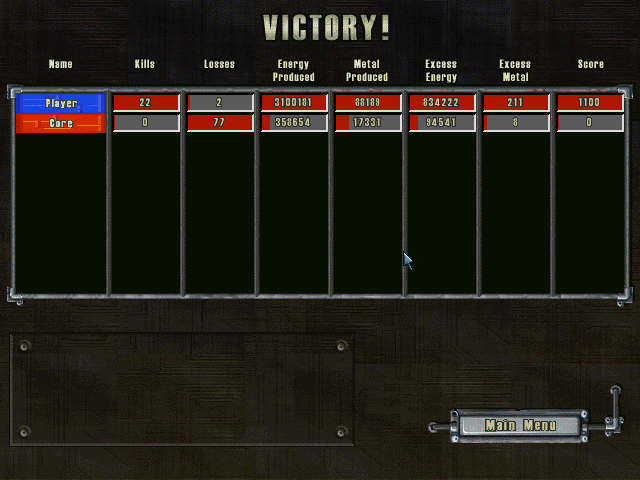The Joy of Total Annihilation
This is an entry to Archdruid Gaming's Gaming Decades: The 90's contest. I strongly suggest checking them out if you're interested in games and joining one of the friendliest communities on Steem (which is quite a competitive field).
If I had to name a game as my childhood game, it would be Total Annihilation.
Or, maybe, Dungeon Siege (also designed by Chris Taylor with a soundtrack by Jeremy Soule).
But certainly of the earlier stages of my life, Total Annihilation is what stands out.
I mean, just look at its intro video!
As an added bonus, this video is more or less reflective of the gameplay, which you can't always say about game intros!
Total Annihilation wasn't my first real-time strategy game. It wasn't even my second. It might have been my third, but I don't even have a guarantee of that. I remember Command and Conquer and the original Age of Empires being around and in my life, the latter of which I played quite a deal before Age of Empires II came out and stole my time (however, I didn't get into AoE II until the 00's, so take it with a grain of salt).
When Total Annihilation came out, my brother and I were still young enough that my dad insisted we call it "Total Robot" around my mom so that she didn't get anxious about violent video games. Since the violence in the game takes place between robots, I suppose this isn't too unreasonable a renaming scheme, but it seems kind of silly in hindsight. My mother didn't seem to care either way.

Cover image courtesy of MobyGames.
As a strategy game, Total Annihilation has not aged perfectly, but it's aged pretty well. It was one of the largest scale strategy games of its time (barring military simulations, which were generally based on board games and took the form of turn-based strategy games), though its unit limit was still around 200, which wasn't necessarily exceptionally large.
One of the things that made its scale so massive was the map size, and the use of combined arms forces; it was rare to see encounters between forces with units standing at maximum range and taking pot-shots at each other while blocking other units' line of fire, especially since the addition of air units that flew over and beyond their targets meant that there was a lot of dynamic movement on the battlefield.
Unprecedented Dynamics
Another factor here is that unlike Age of Empires and Command and Conquer, which generally had a rock-paper-scissors combat system, Total Annihilation used actual physics to track projectiles rather than computing attacks as a function of units. This meant that engagements felt a lot more authentic and less structured (TA actually has a high degree of opacity: players don't have access to the numbers that govern things behind the scenes during the game itself).
This means, for instance, that a naval battleship can shoot a plasma cannon at an enemy aircraft (though it is much more likely to hit something a good distance behind its original target as the shot flies past harmlessly and gravity takes over). The effect is that the game feels more dynamic than a lot of other games, since you couldn't predict what was going to happen with absolute certainty.

Establishing a beachfront.
Unique Economy System
The economic system of Total Annihilation is uniquely dynamic as well. Unlike other games of its day (and, for that matter, most RTS games even now), it has a resource "streaming" system. Many actions requires a certain amount of resources (typically energy), with the exception of some of the less significant things, but it's not paid up front.
For instance, the massive battleships in the picture above actually generate energy (50 per second), but consume 48 energy per second when moving. When their guns fire, it consumes even more energy, but only for a short amount of time.
Building consumes a steady trickle of resources, as opposed to having the cost be paid up-front, and if resources run out then the process slows to a crawl. Each builder has its own rate at which it can consume resources (e.g. the commander unit, who I'll discuss more later), and as a result they take different times to build the same things. I'm a fan of air-based strategies, but the construction airplanes are the slowest builders of all the construction units (at least relative to their cost).
Resources are typically generated by buildings, and come from a potentially unlimited pool. This means that unlike some of the other strategy games of its day (Age of Empires, most notably), there is no natural limit to the length of the games, leading to some truly epic battles.
Resource management also matters a lot more in combat. If your resources run out while your units are in battle, they may not even be able to fire their weapons if the energy can't be scrounged up. This isn't usually such a great issue, as the game has pretty sensible prioritization of how resources are distributed, but having opponents launch a crippling attack on your base can lead to a death spiral as your defenses go down, or be relatively trivial if you have prepared and kept enough energy in reserve to repel their assault and rebuild your power grid.

A reasonably developed home base.
Tech-Free Tier System
One of the other interesting things about Total Annihilation is that it has a tier-based tech tree without any research. It functions similar to Command and Conquer in some regards, but it is different in other ways.
The central factor in the game is the commander. A commander unit is capable of building only low-tier structures on its own accord (though it can contribute to the construction of higher-tier structures) and is a capable combatant. However, the commander also serves the same role as the king in chess: it's not the strongest unit, and if you lose it you often lose the game (this is optional, but is also the default setting).
The commander also explodes violently when it is destroyed, causing more than a little collateral damage in most situations.
The goal of the commander in the early game is to build a tier-1 unit construction facility, and then secure basic resources (in either order).
Each of the tier-1 unit construction facilities can build construction units, which themselves can build tier-2 facilities of their own type or other tier-1 facilities. Seaplanes and hovercraft, introduced in the Core Contingency expansion, occupy an unusual Tier 1.5 role; their respective factories cannot be built by the commander, but may be built by any tier-1 builder.
With k-bots (walkers), traditional ground vehicles, air units, and naval units as the four core build trees, Total Annihilation gives a fair amount of options in any environment. Air tends to be the weakest tree (almost every unit and defensive structure can attack air units, even if poorly), but makes up for it with powerful bombers and high mobility; the air constructor can build anywhere on the map, enabling cheeky strategies like building a beachhead behind enemy lines or placing artillery batteries on an inaccessible hilltop.
Tier-2 resource generation and special facilities far outstrips the tier-1 options, including missile silos that can devastate enemy forces from across the map and artillery pieces with absurd range. However, the cost in resources to build these structures is equivalently increased, and trying to build missiles to strike an enemy down from across the map is expensive and time-consuming when a quick attack force can slip past base defenses easily.

To be fair, this was against an easy AI, who I only defeated because their commander wandered into stray missile-fire from my navy aiming to pacify a defensive battery.
Bringing It Together
Total Annihilation feels its age. It doesn't look as bad as it could (the fact that it runs really well in the GOG re-release at 1920x1080 is a nice touch), but it does have some noteworthy problems with it, namely a UI that is not particularly engaging and pathfinding that demands a lot of micromanagement. There's no formation option, so your fastest units need to be commanded not to arrive first–unless they just get stuck behind your slower units.
It also has some neat features that are ahead of their times. Queued construction and commands are nice (and something that other respectable RTS games took way too long to adopt: Age of Empires being a notable offender), and the fluidity of gameplay would perhaps not be matched until many years later.
However, the real triumph of Total Annihilation for me will always be the memories that it has fostered. As one of the few games that my dad, my brother, and myself would all play (the only other game that achieved this quite as well was The Sims), it was a family bonding experience, especially since my brother and I were too young to play independently when the game first came out and had to work together to figure out good strategies. Its tremendous Jeremy Soule soundtrack (which is not particularly characteristic of his other work) is still inspiring to this day, and his future work with Chris Taylor on Dungeon Siege would mark another formative part of my early gaming career.
What Total Annihilation lacks in modern polish, it made up for in revolutionary strides in graphics and gameplay. The UI is clunky, there is not as much depth as there could be, and there were some notable issues with the AI, but all of that melts away even today if one returns to it and looks at it as it is.
Legacy
Total Annihilation would become a cult classic (or maybe even just a classic), earning its stars by combining a strong sense of what makes games work with ideas that would become standard in later titles.
As a game which supported modification, it spawned quite a few third-party unit and map packs, including large mods that would go on to lead to an open-source engine rebuild (actually several; the one that has spawned the most widespread interest is the Spring engine), and a spiritual successor in the form of Supreme Commander.
Total Annihilation didn't have as much mainstream appeal as Command and Conquer, Age of Empires, or Starcraft, and its publisher went defunct not long after its initial release, but in an era where many other games came and went–who remembers Dark Reign?–Total Annihilation would leave a mark on dedicated fans and earn a persistent foothold in the annals of strategy games long past its initial reign of glory, the inexorable fight between the Arm and the Core still rages on.
This post was shared in the Curation Collective Discord community for curators, and upvoted and resteemed by the @c-squared community account after manual review.
@c-squared runs a community witness. Please consider using one of your witness votes on us here
To listen to the audio version of this article click on the play image.

Brought to you by @tts. If you find it useful please consider upvoting this reply.
Hi loreshapergames,
Visit curiesteem.com or join the Curie Discord community to learn more.
I still play total annihilation Kingdoms to this day. Great games!
I still play total
Annihilation Kingdoms
To this day. Great games!
- ma1neevent
I'm a bot. I detect haiku.
I didn't get into TA: Kingdoms as much. Something about the resource system changing just didn't appeal to me terribly, but it's still a game that has a lot of interesting concepts.
Ah this was a superb game! The stunningly sheer scale (at the time) of the units and the maps was completely mind blowing! Great choice!
I have one of the more recent remakes to play... Planetary Annihilation?
I Kickstarted Planetary Annihilation, and it was interesting. Probably one of the more true to TA modern successors (even considering something like Supreme Commander), though with the addition of an interplanetary system.
Unfortunately, I don't really remember it all that well, in part because my computer at the time was a little underpowered to run it. I should go back and try it on a better system.
I really should give it a go soon, I'm trying to finish a few games before I start anything new though...
I love TA and I still play it from time to time.
There are also some remakes which are not that bad either, maybe because it connects to my love for TA xD
Du erhieltest aufgrund deiner LanaCharleenToken ein Upvote von @sebescen81 und von @lanacharleen
Vielen lieben Dank für euren Support. Der Account meiner Tochter wächst und gedeiht.
TA is the sort of game that I find refreshing whenever I get a little burnt out on games. It's definitely got places where it shows its age, but it and its successors just feel right in a way that a lot of other strategy games don't.
Its resource economy is probably one of the best elements: I don't think there's another strategy game out there (barring its successors) that handles the system so fluidly. It almost feels more like a grand strategy game like Europa Universalis or Stellaris in the fact that you're more setting goals than making transactions, and you don't need to micro it as much as you do in something like Age of Empires.
Congratulations @loreshapergames!
Your post was mentioned in the Steem Hit Parade in the following category: